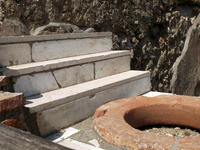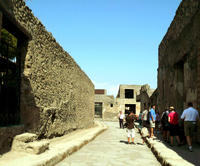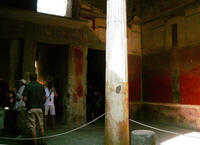You are in: Europe -> Italy -> Archaeological Areas... , and traditional search or Image Gallery will yield results of this site only
Archaeological Areas of Pompei, Herculaneum and Torre Annunziata
| Site number: | 829 |
|
| Type of site: | Cultural | |
| Date: | A.D. 79 | |
| Date of Inscription: | 1997 | |
| Location: | Europe, Italy, Campania, Province of Naples | |
Up to 75 images are shown here. Click on each for more details or on Image Gallery for more images.
Six official UN languages:
Arabic,
Chinese,
English,
French,
Russian,
Spanish
Other languages: Bulgarian, Catalan, Croatian, Czech, Danish, Dutch, Esperanto, Estonian, Finnish, Galician, German, Hebrew, Hungarian, Icelandic, Indonesian, Italian, Japanese, Latin, Lithuanian, Luxembourgish, Macedonian, Norwegian-bokmål, Norwegian-nynorsk, Polish, Portuguese, Romanian, Slovak, Swedish, Thai, Turkish, Vietnamese
Other languages: Bulgarian, Catalan, Croatian, Czech, Danish, Dutch, Esperanto, Estonian, Finnish, Galician, German, Hebrew, Hungarian, Icelandic, Indonesian, Italian, Japanese, Latin, Lithuanian, Luxembourgish, Macedonian, Norwegian-bokmål, Norwegian-nynorsk, Polish, Portuguese, Romanian, Slovak, Swedish, Thai, Turkish, Vietnamese
| Description: | The two prosperous Roman towns of Pompeii and Herculaneum, as well as the several wealthy villas in the area, were engulfed when Vesuvius erupted on 24 August A.D. 79. Since the mid-18th century they have gradually been unearthed and presented to the public. Pompeii’s immense commercial town contrasts with the smaller but better-preserved remnants of the holiday resort of Herculaneum; whereas Villa Oplontis’s wonderful wall paintings at Torre Annunziata present a vivid impression of the luxurious lifestyle of the more affluent citizens of the Early Roman Empire. --WHMNet paraphrase from the description at WHC Site, where additional information is available. For 360 degree imaging of this site, click here. | |
| Pompeii is a buried and ruined Roman city near modern Naples in the Italian region of Campania, in the territory of the comune of Pompei. It, along with Herculaneum (its sister city), was destroyed, and completely buried, during a catastrophic eruption of the volcano Mount Vesuvius spanning two days on 24 August 79. The volcano collapsed higher roof-lines and buried Pompeii under many meters of ash and pumice, and it was lost for nearly 1700 years before its accidental rediscovery in 1748. Since then, its excavation has provided an extraordinarily detailed insight into the life of a city at the height of the Roman Empire. Today, it is one of the most popular tourist attractions of Italy and a UNESCO World Heritage Site. Herculaneum (in modern Italian Ercolano) is an ancient Roman town, located in the territory of the current commune of Ercolano. Its ruins can be found, in the Italian region of Campania. It is most famous for having been lost, along with Pompeii, in the eruption of Mount Vesuvius beginning on August 24, AD 79, which buried Herculaneum in volcanic mud. Since the discovery of bones in 1981, some 150 skeletons have been found. Torre Annunziata is a city and commune in the province of Naples, region of Campania in Italy. It is located at the Gulf of Naples at the foot of Mt. Vesuvius. The city was destroyed in the Vesuvius eruption of 79 AD and in 1631. The city was once the seat of important ironwork (Deriver, Dalmine) and food processing industries. Today industries still active include naval and pharmaceutical ones. The archaeological site of Oplonti is a UNESCO World Heritage site since 1997. --Wikipedia. Text is available under the Creative Commons Attribution-ShareAlike License. For 360 degree imaging of this site, click here. | ||
| Source: | http://whc.unesco.org/en/list/829 | |
| Source2: | http://whc.unesco.org/en/list/829/video | |
| Reference: | 1. UNESCO World Heritage Center, Site Page. | |












































































